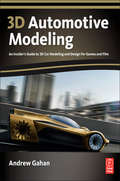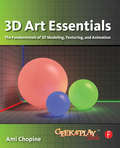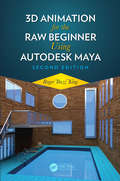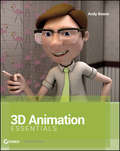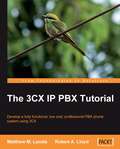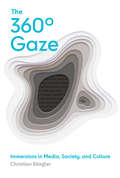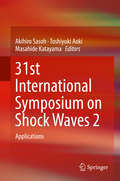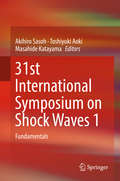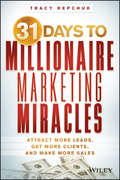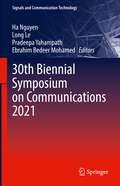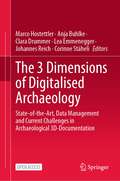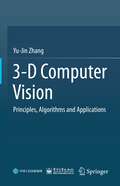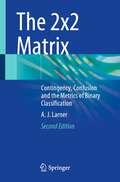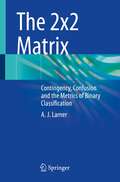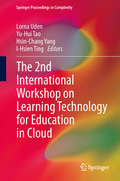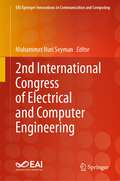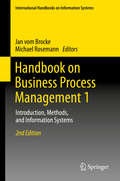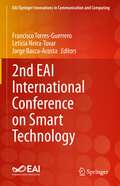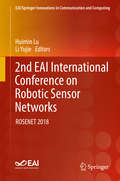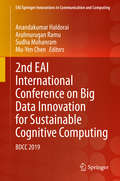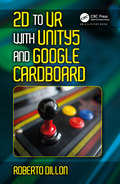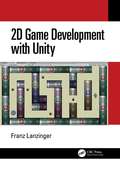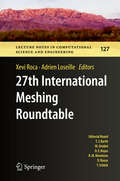- Table View
- List View
3d Automotive Modeling: An Insider's Guide to 3d Car Modeling and Design for Games and Film
by Andrew GahanMaster techniques from top automotive designers and world-class game developers with this insider's guide to designing and modeling 3D vehicles. With techniques demonstrated in 3ds Max, Maya, XSI, and Photoshop, "3D Automotive Modeling" starts with a fantastic series of hot concept designs and continues by offering a full hands-on modeling tutorial for each. Some of the very best designers and modelers from across the globe take you through their processes step-by-step, giving you the tips, tricks, and short-cuts that true professionals use. "3D Automotive Modeling" features tutorials from Honda, Toyota, and Mercedes-Benz designers, as well as modelers from Sony Computer Entertainment, Lucas Arts, and Simbin-artists who have worked on some of the biggest games in the industry, including the MotorStorm series. You will get: insider tips from a team of noted professionals, led by author Andrew Gahan, part of the award-winning game team behind the PlayStation 3 smash hit series, MotorStorm; all tutorial files, models, textures, blueprints, and concept images on the associated web site; and, access to a vibrant forum on the web site where you can discuss and share your work and get feedback from the pros.
3D Art Essentials: The Fundamentals Of 3d Modeling, Texturing, And Animation
by Ami ChopineCreate high-quality 3D animations and models by using the basic concepts and principles of 3D art presented by GeekAtPlay.com's Ami Chopine. This handy studio reference breaks down the core concepts into easy-to-understand segments and teaches you the 'why' in addition to the 'how.' Using application agnostic step-by-step tutorials, this book teaches you how to model, pose, and texture your creations as well as scenery creation, animation, and rendering. Learn which applications are best for your needs and how you can get started making money in the 3D field. The companion website includes video tutorials, models, project files, and other resources. This book is endorsed by Daz3d.com and includes exclusive Daz3d models.
3D Animation for the Raw Beginner Using Autodesk Maya 2e
by Roger King3D Animation for the Raw Beginner Using Autodesk Maya is a hands-on academic textbook as well as a do-it-yourself training manual for the individual animator. This second edition has been completely rewritten to take into account updates to Autodesk Maya, including Autodesk’s renderer, Arnold. It contains entirely new examples and tutorial lessons. All 612 images are in full color. The book directs the reader to the parts of Maya that must be mastered in order to create complete 3D projects, and thus it simplifies the process of taking on Maya’s vast and intricate interface, while giving the reader a firm foundation on which to build future knowledge of Maya. It also presents brief examples of other popular 3D applications and rendering engines. This principles-based, yet pragmatic book: Introduces the basic steps of the 3D modeling, materials, animation, lighting, and rendering processes. Presents clear and concise tutorials that link key concepts to practical techniques. Includes access to a webpage for the book: https://buzzking.com/AnimationTextbook/AnimationTextbook.html. On this webpage are videos that cover many of the lessons in the book, as well as video tutorials that present bonus material not included in the book. Frees instructors from the painstaking task of developing step-by-step examples to present Maya’s complex interface and basic capabilities. Boasts an easy-to-follow, tutorial-based learning style ideal for individual study by aspiring animators and do-it yourselfers. Roger "Buzz" King is a Professor Emeritus at the University of Colorado at Boulder, where he teaches 3D Animation for the Computer Science Department and the Alliance for Technology, Learning, and Society (ATLAS), an institute dedicated to the application of technology to the arts. Buzz is an independent 3D animator who serves on the board of directors of a 3D animation startup. Buzz has a B.A. in Mathematics from Occidental College, an M.S. and Ph.D. in Computer Science from the University of Southern California, and an M.Div. from the Iliff School of Theology. Key Features Introduces critical aspects of the 3D animation process Presents clear and concise tutorials that link key concepts to practical techniques Includes access to a dedicated Web site, http://3dbybuzz.com, featuring useful videos, lessons, and updates Frees instructors from developing step-by-step examples to present Maya’s complex interface and basic Boasts an easy-to-follow, hands-on learning style ideal for individual study by aspiring animators and do-ityourselfers
3D Animation Essentials
by Andy BeaneThe essential fundamentals of 3D animation for aspiring 3D artists3D is everywhere--video games, movie and television special effects, mobile devices, etc. Many aspiring artists and animators have grown up with 3D and computers, and naturally gravitate to this field as their area of interest. Bringing a blend of studio and classroom experience to offer you thorough coverage of the 3D animation industry, this must-have book shows you what it takes to create compelling and realistic 3D imagery. Serves as the first step to understanding the language of 3D and computer graphics (CG)Covers 3D animation basics: pre-production, modeling, animation, rendering, and post-productionDissects core 3D concepts including design, film, video, and gamesExamines what artistic and technical skills are needed to succeed in the industryOffers helpful real-world scenarios and informative interviews with key educators and studio and industry professionalsWhether you're considering a career in as a 3D artist or simply wish to expand your understanding of general CG principles, this book will give you a great overview and knowledge of core 3D Animation concepts and the industry.
The 3CX IP PBX Tutorial
by Robert Lloyd Matthew M. LandisA hands-on and practical tutorial that shows administrators how to implement and use 3CX and its range of functionality. Using real world experiences from the authors, you will learn tricks and tips that will help you develop and optimize your 3CX system. This book is for beginners who know nothing about 3CX or VoIP. It will guide them to set up a complete system. Advanced users will also gain insight from information on real-world hardware and software tips and tricks.
The 360° Gaze: Immersions in Media, Society, and Culture
by Christian StieglerA comprehensive study of the pervasive role of immersion and immersive media in postmodern culture, from a humanities and social sciences perspective.Virtual reality, augmented reality, mixed reality, and other modes of digitally induced immersion herald a major cultural and economic shift in society. Most academic discussions of immersion and immersive media have focused on the technological aspects. In The 360° Gaze, Christian Stiegler takes a humanities and social science approach, emphasizing the human implications of immersive media in postmodern culture. Examining characteristics common to all immersive experiences, he uncovers dominant metaphors, such as the rabbit hole, and prevailing ideologies. He raises fundamental questions about opportunities and risks associated with immersion, as well as the potential effects on individuals, communities, and societies.
31st International Symposium on Shock Waves 2: Applications
by Akihiro Sasoh Toshiyuki Aoki Masahide KatayamaThis is the second volume of a two volume set which presents the results of the 31st International Symposium on Shock Waves (ISSW31), held in Nagoya, Japan in 2017. It was organized with support from the International Shock Wave Institute (ISWI), Shock Wave Research Society of Japan, School of Engineering of Nagoya University, and other societies, organizations, governments and industry. The ISSW31 focused on the following areas: Blast waves, chemical reacting flows, chemical kinetics, detonation and combustion, ignition, facilities, diagnostics, flow visualization, spectroscopy, numerical methods, shock waves in rarefied flows, shock waves in dense gases, shock waves in liquids, shock waves in solids, impact and compaction, supersonic jet, multiphase flow, plasmas, magnetohyrdrodynamics, propulsion, shock waves in internal flows, pseudo-shock wave and shock train, nozzle flow, re-entry gasdynamics, shock waves in space, Richtmyer-Meshkov instability, shock/boundary layer interaction, shock/vortex interaction, shock wave reflection/interaction, shock wave interaction with dusty media, shock wave interaction with granular media, shock wave interaction with porous media, shock wave interaction with obstacles, supersonic and hypersonic flows, sonic boom, shock wave focusing, safety against shock loading, shock waves for material processing, shock-like phenomena, and shock wave education. These proceedings contain the papers presented at the symposium and serve as a reference for the participants of the ISSW 31 and individuals interested in these fields.
31st International Symposium on Shock Waves 1: Fundamentals
by Akihiro Sasoh Toshiyuki Aoki Masahide KatayamaThis is the first volume of a two volume set which presents the results of the 31st International Symposium on Shock Waves (ISSW31), held in Nagoya, Japan in 2017. It was organized with support from the International Shock Wave Institute (ISWI), Shock Wave Research Society of Japan, School of Engineering of Nagoya University, and other societies, organizations, governments and industry. The ISSW31 focused on the following areas: Blast waves, chemical reacting flows, chemical kinetics, detonation and combustion, ignition, facilities, diagnostics, flow visualization, spectroscopy, numerical methods, shock waves in rarefied flows, shock waves in dense gases, shock waves in liquids, shock waves in solids, impact and compaction, supersonic jet, multiphase flow, plasmas, magnetohyrdrodynamics, propulsion, shock waves in internal flows, pseudo-shock wave and shock train, nozzle flow, re-entry gasdynamics, shock waves in space, Richtmyer-Meshkov instability, shock/boundary layer interaction, shock/vortex interaction, shock wave reflection/interaction, shock wave interaction with dusty media, shock wave interaction with granular media, shock wave interaction with porous media, shock wave interaction with obstacles, supersonic and hypersonic flows, sonic boom, shock wave focusing, safety against shock loading, shock waves for material processing, shock-like phenomena, and shock wave education. These proceedings contain the papers presented at the symposium and serve as a reference for the participants of the ISSW 31 and individuals interested in these fields.
31 Days to Millionaire Marketing Miracles
by Tracy Repchuk31 Days to Millionaire Marketing Miracles is a breakthrough blueprint outlining the proven steps for successfully attracting more leads, getting more clients, and making more sales. Author Tracy Repchuk shows entrepreneurs, business owners, and opportunity-seekers what to do, when to do it, and the order in which it needs to be done to build an online marketing presence that is stable, predictable, and expandable. Whether you want to dominate your market globally or locally, this thirty-one-day guide allows you to take your product, service, or message, and turn it into a moneymaking machine.Best Selling Author Tracy Repchuk is recognized as the Top Woman Speaker in the World for Internet Marketing and an entrepreneur in the IT and internet industry since 1985Serves as a reference guide to newbies and entrepreneurs wanting to turn their passion into profits and accelerate business results31 Days to Millionaire Marketing Miracles guides you along a proven path to profits and shows you an Internet marketing formula that will attract more leads, get more clients, and make more sales
30th Biennial Symposium on Communications 2021 (Signals and Communication Technology)
by Ha Nguyen Long Le Pradeepa Yahampath Ebrahim Bedeer MohamedThe book presents the proceedings of the 30th Biennial Symposium on Communications 2021 (BSC21), a prestigious international research conference in communications, information theory, and signal processing. Started in 1962 by Queen’s University, Canada, the Symposium is now presented by the Canadian Society of Information Theory. Its 30th edition was hosted virtually by The University of Saskatchewan and held in Saskatoon from June 28 to 30, 2021. Topics include Communication and Information Theory, Coding and Signal Processing for Communications, and Multiple Antenna Systems and Cooperative Communications.
The 3 Dimensions of Digitalised Archaeology: State-of-the-Art, Data Management and Current Challenges in Archaeological 3D-Documentation
by Marco Hostettler Anja Buhlke Clara Drummer Lea Emmenegger Johannes Reich Corinne StäheliThis open access book aims to provide an overview of state-of-the-art approaches to 3D documentation from a practical perspective and formulate the most important areas for future developments. Bringing together a wide range of case studies, examples of best practice approaches, workflows, and first attempts to establish sustainable solutions to pressing problems, this book offers readers current practical advice on how to approach 3D archaeology and cultural heritage.Divided into five parts, this book begins with an overview of 3D archaeology in its present state. It goes on to give insights into the development of the technology and recent cutting-edge applications. The next section identifies current challenges in 3D archaeology and then presents approaches and solutions for data management of a large number of 3D objects and ways to ensure sustainable solutions for the archiving of the produced data. This book will be of interest to researchers working in the fields of archaeology, heritage management, and digital humanities in general.
The 3-D Global Spatial Data Model: Principles and Applications, Second Edition
by Earl F. BurkholderTraditional methods for handling spatial data are encumbered by the assumption of separate origins for horizontal and vertical measurements, but modern measurement systems operate in a 3-D spatial environment. The 3-D Global Spatial Data Model: Principles and Applications, Second Edition maintains a new model for handling digital spatial data, the global spatial data model or GSDM. The GSDM preserves the integrity of three-dimensional spatial data while also providing additional benefits such as simpler equations, worldwide standardization, and the ability to track spatial data accuracy with greater specificity and convenience. This second edition expands to new topics that satisfy a growing need in the GIS, professional surveyor, machine control, and Big Data communities while continuing to embrace the earth center fixed coordinate system as the fundamental point of origin of one, two, and three-dimensional data sets. Ideal for both beginner and advanced levels, this book also provides guidance and insight on how to link to the data collected and stored in legacy systems.
3-D Computer Vision: Principles, Algorithms and Applications
by Yu-Jin ZhangThis textbook offers advanced content on computer vision (basic content can be found in its prerequisite textbook, “2D Computer Vision: Principles, Algorithms and Applications”), including the basic principles, typical methods and practical techniques. It is intended for graduate courses on related topics, e.g. Computer Vision, 3-D Computer Vision, Graphics, Artificial Intelligence, etc. The book is mainly based on my lecture notes for several undergraduate and graduate classes I have offered over the past several years, while a number of topics stem from my research publications co-authored with my students. This book takes into account the needs of learners with various professional backgrounds, as well as those of self-learners. Furthermore, it can be used as a reference guide for practitioners and professionals in related fields. To aid in comprehension, the book includes a wealth of self-test questions (with hints and answers). On the one hand, these questions help teachers to carry out online teaching and interact with students during lectures; on the other, self-learners can use them to assess whether they have grasped the key content.
3-D Computer Graphics
by Samuel R. BussThis introduction to 3D computer graphics emphasizes fundamentals and the mathematics underlying computer graphics, while also covering programming techniques using OpenGL, a platform-independent graphics programming environment. The minimal prerequisites make it suitable for self-study or for use as an advanced undergraduate or introductory graduate text as the author leads step-by-step from the basics of transformations to advanced topics such as animations and kinematics. Accompanying software, including source code for a ray tracing software package, is available freely from the book's web site.
The 2x2 Matrix: Contingency, Confusion and the Metrics of Binary Classification
by A. J. LarnerThis book describes, extends, and illustrates the metrics of binary classification through worked examples.Worked examples based on pragmatic test accuracy study data are used in chapters to illustrate relevance to day-to-day clinical practice. Readers will gain an understanding of sensitivity and specificity and predictive values along with many other parameters.The contents are highly structured, and the use of worked examples facilitates understanding and interpretation.This book is a resource for clinicians in any discipline who are involved in the performance or assessment of test accuracy studies and professionals in the disciplines of machine learning or informatics wishing to gain insight into clinical applications of 2x2 tables.
The 2x2 Matrix: Contingency, Confusion and the Metrics of Binary Classification
by A.J. LarnerThis book presents and discusses the numerous measures of test performance that can be derived from 2x2 tables. Worked examples based on pragmatic test accuracy study data are used in chapters to illustrate relevance to day-to-day clinical practice. Readers will gain a good understanding of sensitivity and specificity and predictive values along with many other parameters.The contents are highly structured and the use of worked examples facilitates understanding and interpretation. This book is a resource for clinicians in any discipline who are involved in the performance or assessment of test accuracy studies, and professionals in the disciplines of machine learning or informatics wishing to gain insight into clinical applications of 2x2 tables.
The 2nd International Workshop on Learning Technology for Education in Cloud
by Lorna Uden I-Hsien Ting Hsin-Chang Yang Yu-Hui TaoProceedings from the 2013 LTEC conference in Kaohsiung, Taiwan. The papers examine diverse aspects of Learning Technology for Education in Cloud environments, including social, technical and infrastructure implications. Also addressed is the question of how cloud computing can be used to design applications to support real time on demand learning using technologies. The workshop proceedings provide opportunities for delegates to discuss the latest research in TEL (Technology Enhanced Learning) and its impacts for learners and institutions, using cloud technologies.
2nd International Congress of Electrical and Computer Engineering (EAI/Springer Innovations in Communication and Computing)
by Muhammet Nuri SeymanThis proceedings presents the papers included in the 2nd International Congress of Electrical and Computer Engineering (ICECENG), which took place in Bandirma, Turkey, 22-25 November 2023. The conference aims to bring together researchers, developers, and students in computing, technology trends, artificial intelligence, and security who are interested in studying the application of formal methods to the construction and analysis of models describing technological processes at both micro and macro levels. ICECENG’23 also aims to provide a platform for discussing the issues, challenges, opportunities, and findings of computer engineering research. The conference seeks to provide some answers and explore the processes, actions, challenges, and outcomes of learning and teaching.
, 2nd Edition: Introduction, Methods, and Information Systems (International Handbooks on Information Systems)
by Jan Vom Brocke Michael RosemannBusiness Process Management (BPM) has become one of the most widely used approaches for the design of modern organizational and information systems. The conscious treatment of business processes as significant corporate assets has facilitated substantial improvements in organizational performance but is also used to ensure the conformance of corporate activities. This Handbook presents in two volumes the contemporary body of knowledge as articulated by the world' s leading BPM thought leaders. This first volume focuses on arriving at a sound definition of BPM approaches and examines BPM methods and process-aware information systems. As such, it provides guidance for the integration of BPM into corporate methodologies and information systems. Each chapter has been contributed by leading international experts. Selected case studies complement their views and lead to a summary of BPM expertise that is unique in its coverage of the most critical success factors of BPM.<P><P> The second edition of this handbook has been significantly revised and extended. Each chapter has been updated to reflect the most current developments. This includes in particular new technologies such as in-memory data and process management, social media and networks. A further focus of this revised and extended edition is on the actual deployment of the proposed theoretical concepts. This volume includes a number of entire new chapters from some of the world's leading experts in the domain of BPM.
2nd EAI International Conference on Smart Technology (EAI/Springer Innovations in Communication and Computing)
by Francisco Torres-Guerrero Leticia Neira-Tovar Jorge Bacca-AcostaThis book presents the proceedings of 2nd EAI International Conference on Smart Technology (MTYMEX), which took place April 27th, 2021, online and in Monterrey, Mexico. MTYMEX is an international conference aimed at demonstrating the potential of new applications for the Internet in the future. The authors offer perspectives on research on smart technologies in society, including the results of research projects on virtual reality, blockchain, artificial intelligence, and smart cities. The book offers examples of applications with smart technologies in different knowledge areas. The conference brings together the academic, research and private sectors working on applications and smart devices for e-health and smart cities.
2nd EAI International Conference on Robotic Sensor Networks: ROSENET 2018 (EAI/Springer Innovations in Communication and Computing)
by Huimin Lu Li YujieThis book provides scientific research into Cognitive Internet of Things for Smart Society, with papers presented at the 2nd EAI International Conference on Robotic Sensor Networks. The conference explores the integration of networks and robotic technologies, which has become a topic of increasing interest for both researchers and developers from academic fields and industries worldwide. The authors posit that big networks will be the main approach to the next generation of robotic research, with the explosive number of networks models and increasing computational power of computers significantly extending the number of potential applications for robotic technologies while also bringing new challenges to the network's community. The 2nd EAI International Conference on Robotic Sensor Networks was held 25-26 August 2018 at the Kitakyushu International Conference Center (MICE), Kitakyushu, Japan.
2nd EAI International Conference on Big Data Innovation for Sustainable Cognitive Computing: BDCC 2019 (EAI/Springer Innovations in Communication and Computing)
by Anandakumar Haldorai Arulmurugan Ramu Sudha Mohanram Mu-Yen ChenThis proceeding features papers discussing big data innovation for sustainable cognitive computing. The papers feature details on cognitive computing and its self-learning systems that use data mining, pattern recognition and natural language processing (NLP) to mirror the way the human brain works. This international conference focuses on cognitive computing technologies, from knowledge representation techniques and natural language processing algorithms to dynamic learning approaches. Topics covered include Data Science for Cognitive Analysis, Real-Time Ubiquitous Data Science, Platform for Privacy Preserving Data Science, and Internet-Based Cognitive Platform. The 2nd EAI International Conference on Big Data Innovation for Sustainable Cognitive Computing (BDCC 2019) took place in Coimbatore, India on December 12-13, 2019.Contains proceedings from 2nd EAI International Conference on Big Data Innovation for Sustainable Cognitive Computing (BDCC 2019), Coimbatore, India, December 12-13, 2019;Features topics ranging from Data Science for Cognitive Analysis to Internet-Based Cognitive Platforms;Includes contributions from researchers, academics, and professionals from around the world.
2D to VR with Unity5 and Google Cardboard
by Roberto DillonThe book provides an up-to-date introduction to the latest version of Unity and its workflow by guiding readers through various prototypes. These range from 2D to 3D game concepts for PC and mobile, will allow readers to get acquainted with several important concepts and allow them to become competent Unity developers able to learn at their own pace. The book starts by introducing Unity and proceeds in building a basic understanding of its main components by developing a first, simple 2D game before proceeding in developing a full casual game to development of a simple but immersive 3D game concept to be tested first on PC before exploring how to port it for mobile VR.using Google Cardboard.
2D Game Development with Unity
by Franz LanzingerThis book teaches beginners and aspiring game developers how to develop 2D games with Unity. Thousands of commercial games have been built with Unity. The reader will learn the complete process of 2D game development, step by step. The theory behind each step is fully explained. This book contains numerous color illustrations and access to all source code and companion videos. Key Features: Fully detailed game projects from scratch. Beginners can do the steps and create games right away. No coding experience is necessary. Numerous examples take a raw beginner toward professional coding proficiency in C# and Unity. Includes a thorough introduction to Unity 2020, including 2D game development, prefabs, cameras, animation, character controllers, lighting, and sound. Includes a step-by-step introduction to Unity 2019.3. Extensive coverage of GIMP, Audacity, and MuseScore for the creation of 2D graphics, sound effects, and music. All required software is free to use for any purpose including commercial applications and games. Franz Lanzinger is the owner and chief game developer of Lanzinger Studio, an independent game development and music studio in Sunnyvale, California. He started his career in game programming in 1982 at Atari Games, Inc., where he designed and programmed the classic arcade game Crystal Castles. In 1989, he joined Tengen, where he was a programmer and designer for Ms. Pac-Man and Toobin' on the NES. He co-founded Bitmasters, where he designed and coded games including Rampart and Championship Pool for the NES and SNES, and NCAA Final Four Basketball for the SNES and Sega Genesis. In 1996, he founded Actual Entertainment, publisher and developer of the Gubble video game series. He has a B.Sc. in mathematics from the University of Notre Dame and attended graduate school in mathematics at the University of California at Berkeley. He is a former world record holder on Centipede and Burgertime. He is a professional author, game developer, accompanist, and piano teacher. He is currently working on remaking the original Gubble game in Unity and Blender.
27th International Meshing Roundtable (Lecture Notes in Computational Science and Engineering #127)
by Xevi Roca Adrien LoseilleThe International Meshing Roundtable (IMR) brings together researchers, developers, and application experts in a variety of disciplines, from all over the world, to present and discuss ideas on mesh generation and related topics. The technical papers in this volume present theoretical and novel ideas and algorithms with practical potential, as well as technical applications in science and engineering, geometric modelling, computer graphics, and visualization.
